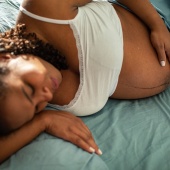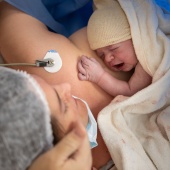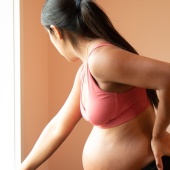Read about what it means if a baby is breech or transverse, and how it might affect labour and birth.
What does the term ‘breech’ mean?
When a baby is ‘presenting by the breech’ or a ‘breech presentation’, it means the baby’s bottom, not their head, is by the cervix. As babies move around a lot in pregnancy it is common and not a concern for most of pregnancy (RCOG, 2017).
By the end of pregnancy, most babies have moved so the head is towards the cervix. However 3 or 4 in 100 will still be breech (RCOG, 2017).
What are the variations of breech?
While the baby has the bottom down, their feet may be in different places (RCOG, 2017):
- Extended or frank – the baby is folded in half, so their feet are by their head
- Flexed or complete – the baby’s knees are bent and their feet tucked up by their bottom
- Footling – one or both feet are below their bottom
What does the term ‘transverse’ mean?
If a baby is transverse, it is lying sideways across the womb. As with breech babies, most babies turn themselves into the head down position by the end of the pregnancy (NHS, 2023).
If the baby does not move into either a settled head down or bottom down position by the end of pregnancy, then a caesarean birth will be recommended. This is to avoid the chance of the cord being born before the baby, which is a medical emergency (NHS, 2023).
How would we know if the baby was breech or transverse?
Some women or pregnant people have a strong awareness of where their baby is lying. When a midwife checks the belly at a routine antenatal appointment, they may say that the baby may be breech or transverse. An ultrasound will confirm the baby’s position.
However, there are occasions when a breech presentation is not spotted until labour has started. Because of this, all midwives are trained to support an unexpected vaginal breech birth.
Why might a baby be breech at the end of pregnancy?
It is more likely that a baby is breech if (RCOG, 2017; Kaur et al, 2025):
- it is a first pregnancy
- the placenta is low-lying (placenta praevia)
- if there is more or less than usual amniotic fluid (the fluid surrounding the baby)
- there are twins or multiple pregnancies
- The uterus is an usual shape, such as bicornuate, which affects around 4 in 1000 women and birthing people
In very rare cases, a baby might be breech due to a health condition which makes it harder for them to move in the womb. This is usually picked up in the 20 week scan (RCOG, 2017).
Developmental Hip Dysplasia (DDH)
A breech baby is more likely to experience Developmental Hip Dysplasia (DDH).
What are the options for birth if the baby is breech?
The options that will be discussed if a baby is breech at 36-37 weeks are (RCOG, 2017):
- Turning the baby, or external cephalic [ke-fal-ik] version (ECV)
- A planned vaginal breech birth
- A planned caesarean birth
External cephalic version (ECV)
External cephalic version, or ECV, is when a specially trained doctor or midwife applies pressure to the bump to turn the baby in a safe way (RCOG, 2017). This offer can be accepted or declined.
ECV usually happens at 36-37 weeks, but can happen right up until labour begins. It can be carried out on most women or pregnant people, even if they have had one caesarean birth before (RCOG, 2017).
ECV takes place at a specialist clinic. This will be at a hospital where an emergency caesarean birth could be performed if necessary. The process is (RCOG, 2017):
- An ultrasound scan is performed to confirm the baby is breech and check for any reasons it would be unwise to perform an ECV.
- The mother or birthing person’s pulse and blood pressure are checked.
- The baby’s heart rate is monitored.
- The mother or birthing person is asked for their consent to proceed with the ECV.
- Medication to relax the muscles of the womb is injected. This can cause the woman or birthing person to be flushed and their heart to beat quicker for a little while.
- The healthcare professional applies external pressure with their hands to the bump to try and move the baby. This can feel uncomfortable, and the doctor will stop if it is painful. It will last a few minutes.
- The ultrasound, and checks on mother or birthing person and baby, will be repeated.
- It will be known immediately if the ECV was successful and the baby has moved into a head down position. In any event, the options for birth will be discussed again.
- If the parent is rhesus D negative they will be offered an injection and blood test.
- Afterwards, the mother or birthing person can usually return home. They will be advised to contact the hospital if they experience any bleeding, tummy pain or contractions, or if the baby seems to be moving less.
Is ECV safe?
ECV is considered safe for the mother or birthing person and baby if carried out by trained medical staff (RCOG, 2017).
There is a 1 in 200 chance of having an emergency caesarean birth immediately after having an ECV because of bleeding from the placenta or changes to the baby’s heartbeat (RCOG, 2017).
ECV is not appropriate if (RCOG, 2017):
- caesarean birth is recommended for other reasons
- the placenta is low-lying or placenta praevia
- the waters have already broken
- there has been recent vaginal bleeding
- the baby’s heart rate is concerning
- in the case of twins or multiple pregnancies
If the ultrasound shows a reason not to perform an ECV then it will not be carried out.
What if ECV doesn’t work?
ECV is successful in about half of cases, and is more likely to work if there has been a previous vaginal birth. The mother or birthing person should be told what the chances of the baby turning are before the procedure is carried out (RCOG, 2017).
If ECV is unsuccessful, the doctor might try again another day if the pregnant woman or person wishes (RCOG, 2017).
Even if successful, there is a small chance that the baby will turn itself back to breech position. This happens in 5 in 100 cases (RCOG, 2017).
Options for birth will be discussed if the baby remains breech (RCOG, 2017).
Will the ECV affect labour?
When labour starts, the chances of having an emergency caesarean birth, or ventouse or forceps being used, are slightly higher than if the baby had always been head down (RCOG, 2017).
Are there ways to turn the baby without ECV?
There is no evidence that adopting certain positions helps a breech baby to turn (RCOG, 2017). However, some parents choose to explore steps which may help change the space within the womb.
There is some evidence that a process called moxibustion at 33-35 weeks of pregnancy might help the baby to move into the head-first position. Moxibustion is a Chinese technique which involves burning dried mugwort near specific points on the body. It should only be performed under the direction of a registered healthcare professional (RCOG, 2017).
Vaginal birth and breech babies
If the baby remains breech, planned vaginal breech birth is usually an option.
With skilled medical care and no other risk factors, vaginal breech birth can be nearly as safe as vaginal birth where the baby is head down. All obstetricians and midwives should be skilled in supporting vaginal breech birth (Impey et al, 2017). Expectant parents can ask the healthcare professionals about their confidence with vaginal breech birth.
With vaginal breech birth there is an increase in the chance of short-term complications for the baby, and a very small increase in the chance of the baby dying (RCOG, 2017).
Complications for the mother or birthing person are lowest with successful vaginal breech birth. However, around 4 in 10 women and birthing people planning a vaginal breech birth go on to have an unplanned caesarean birth (Impey et al, 2017).
In some situations a vaginal birth is strongly discouraged and caesarean birth is recommended (RCOG, 2017).
For vaginal breech birth the woman or birthing person will be advised to give birth in a hospital where emergency caesarean birth is available if needed (RCOG, 2017). Some decide to give birth at home with support from an independent midwife.
Induction of labour is not recommended with a breech presentation (RCOG, 2017).
Although the evidence is not strong, continuous foetal monitoring will be offered as it is believed to increase the chance of a good outcome for the baby (Impey et al, 2017).
What positions are best in labour when the baby is breech?
The woman or birthing person can choose and move between positions. The recommendation may be a semi reclined position, or a position on all fours (Impey et al, 2017).
What about pain management?
The same pain management options as for a straightforward birth will be available. However, epidural pain relief may increase the chance of forceps, ventouse, or caesarean birth (RCOG, 2017).
Caesarean birth
Planned caesarean birth is available for women and pregnant parents when they discover the baby is in a breech position. It will be recommended if the individual situation means that vaginal breech birth is not suitable (RCOG, 2017). Read more in our article on caesarean birth.
What does is mean for the baby?
Research suggests that for breech babies a planned caesarean birth reduces the chance of the baby dying. However, only part of that reduced risk is due to avoiding vaginal breech birth (Impey et al, 2017).
The risk of a breech baby dying after 39 weeks is (Impey et al, 2017):
- 1 in 2,000 for caesarean birth
- and 4 in 2,000 for vaginal breech birth
This compares with 2 in 2,000 for vaginal birth for a baby who is head down (Impey et al, 2017).
What does it mean for the mother or birthing person?
A caesarean birth carries a slightly higher risk for the mother or birthing person. Unplanned caesarean birth puts the mother or birthing person at the highest risk. This happens in 4 out of 10 cases of planned vaginal breech birth (Impey et al, 2017).
When is caesarean birth recommended?
If labour has already started, caesarean birth should not be offered late in labour (Impey et al, 2017).
Caesarean birth will be recommended if the baby is (NHS, 2023):
- a footling breech (one or both feet are below its bottom)
- larger or smaller than average
- in an awkward position, for example with a tilted-back neck
Or if the mother has (NHS, 2023):
- a low-lying placenta or placenta praevia
- pre-eclampsia
Caesarean birth is recommended in the case of twins or multiple births when the first baby is presenting by the breech (RCOG, 2017).
Which kind of birth is right for me?
The mother or birthing person can discuss with the medical team what kind of birth is right for them based on the balance of their wishes and individual situation.
Impey LWM, Murphy DJ, Griffiths M, Penna LK (2017) Green top guideline: Management of Breech Presentation. BJOG; 124: e151–e177. https://doi.org/10.1111/1471-0528.14465
Kaur P, Carlson K, Panneerselvam D. (2025) Bicornuate Uterus. In: StatPearls [Internet]. Treasure Island (FL): StatPearls Publishing; 2025 Jan. https://www.ncbi.nlm.nih.gov/books/NBK560859/ [5 Nov 25]
NHS (2023) What happens if your baby is breech? https://www.nhs.uk/pregnancy/labour-and-birth/what-happens/if-your-baby… [13 Oct 25]
RCOG (2017) Breech baby at the end of pregnancy. https://www.rcog.org.uk/for-the-public/browse-our-patient-information/b… [13 Oct 25]







